Boosting Productivity: ThinkPad and Extra Monitors

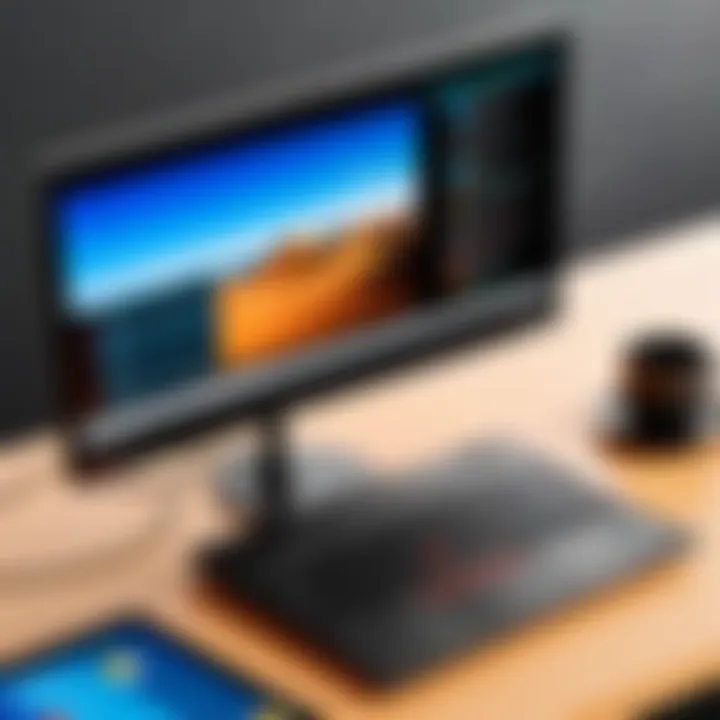
Intro
The integration of additional monitors with Lenovo ThinkPad devices presents a significant opportunity for professionals to enhance their productivity. This approach is especially relevant in today’s fast-paced work environment, where multitasking has become essential. The ThinkPad series is known for its robust performance, durability, and versatility, making it a favorable choice for IT professionals and tech enthusiasts alike. By adding an external monitor, users can create an efficient workspace tailored to their needs.
In this guide, we will explore the hardware specifications needed for an effective setup, delve into the benefits of utilizing multiple displays, and offer implementation strategies to optimize workspace efficiency. Furthermore, we will examine the software tools that can enhance user experience, followed by troubleshooting tips to resolve common issues encountered.
Let’s begin with a detailed overview of the necessary hardware for implementing a multi-monitor setup with your ThinkPad.
Understanding the Need for an Additional Monitor
In today's fast-paced work environment, professionals often find themselves managing a multitude of tasks simultaneously. The emergence of remote work and digital collaboration has heightened the demand for effective productivity tools. One such tool is the additional monitor, which, when combined with a Lenovo ThinkPad, can significantly enhance workflow and efficiency. Utilizing an external display is not merely a matter of aesthetics; it plays a crucial role in optimizing the workspace and improving output quality.
Productivity Gains
Studies have shown that having an additional monitor can lead to substantial productivity gains. The ability to view multiple applications at once can reduce the time spent switching between tabs or windows. According to research from the University of Utah, workers using dual monitors reported increased productivity by up to 40%. This increase is often attributed to a decrease in cognitive load since users can keep all necessary applications visible simultaneously.
Moreover, users can facilitate multitasking by dedicating one screen for communication tools, such as email or chat applications, and the other for documentation or project management. This setup allows for more structured workflow, as professionals can respond to messages and update documents without navigating away from their primary tasks.
Dual-Screen Workflow
Creating a dual-screen workflow presents numerous advantages for IT professionals and tech enthusiasts alike. This approach is especially relevant in technical fields where simultaneous usage of code editors, debugging tools, and design applications is common. By extending their desktop, users can arrange their workspace based on personal preference or project requirements.
- Seamless Communication: Users can engage in video calls or chats while working on their projects. This minimizes distractions and optimizes time management.
- Enhanced Focus: A dual-screen setup can lead to greater focus. Professionals can isolate distractions on one screen, leaving the other for more demanding tasks.
- Improved Accessibility: With two monitors, accessing reference materials or notes becomes easier. This is particularly beneficial during complex work that requires extensive data analysis.
Using a ThinkPad with an additional monitor not only maximizes available screen real estate, but also allows for a customizable workspace tailored to specific tasks. An ideal setup can transform how professionals approach their daily responsibilities, resulting in improved job satisfaction and performance.
"The use of two monitors has become a standard in many industries as it directly contributes to increased productivity and improved work outcomes."
Technical Specifications of ThinkPad Devices
The significance of understanding the technical specifications of ThinkPad devices cannot be overstated, especially when considering their integration with additional monitors. Such knowledge ensures that users can optimize performance, avoid compatibility issues, and enhance productivity through effective multitasking. Key specifications can impact the speed, quality, and efficiency of workflows. Professionals and tech enthusiasts must navigate these details meticulously to achieve their desired outcomes in their daily tasks.
Supported Output Ports
ThinkPad devices come equipped with various output ports, which are crucial for connecting to external monitors. Commonly found ports include HDMI, Mini DisplayPort, and USB-C, each offering distinct advantages. HDMI, for instance, supports both high-definition video and audio, making it a versatile choice for most modern monitors.
USB-C connections are particularly noteworthy due to their ability to transmit data, video, and power through a single cable. This feature simplifies cable management and reduces clutter. Understanding these ports enhances the user's ability to choose the right monitor that aligns with their device's capabilities. Furthermore, compatibility with docking stations enables users to expand their setups effortlessly, catering to diverse work environments.
Graphics Performance
Graphics performance is another critical aspect of ThinkPad specifications. Many ThinkPads feature integrated graphics like Intel UHD or Iris Xe, which provide adequate performance for basic tasks. However, for more intensive applications, users may require a model with discrete graphics, such as the NVIDIA GeForce series.
These discrete options offer superior visual performance, particularly for tasks involving graphic design, video editing, or gaming. Evaluating the graphics performance ensures that users can run multiple applications simultaneously without lag, thus making the most of their multi-monitor setup.
Choosing the Right Monitor
Choosing the right monitor is a foundational aspect of enhancing productivity when using a ThinkPad. The monitor’s specifications affect usability and the overall experience. A suitable monitor not only complements the ThinkPad but also aligns with individual workflow requirements, ensuring optimal efficiency.
When evaluating monitors, key factors such as screen size, resolution, aspect ratio, and panel type should be considered. Each of these elements contributes to how effectively one can multitask and manage different applications simultaneously. Thus, making an informed choice is crucial.
Screen Size and Resolution
Screen size and resolution take center stage when selecting a monitor. A larger screen size can make a notable difference in workspace management. For instance, a 27-inch monitor offers significantly more screen real estate than a smaller 21-inch display. This expansive view can reduce the need for constant window switching, allowing more applications to be visible at once.
Resolution is equally important, defining the clarity and precision of the images and text displayed. Full HD (1920 x 1080) is common but may not suffice for those engaged in graphic design or software development. Upgrading to a 4K monitor (3840 x 2160) can provide sharper details, enhancing the productivity of tasks requiring fine visual acuity.
An ideal practice is to match the monitor's resolution with the screen size. A larger monitor with standard resolution might result in larger but blurred images or text. Therefore, evaluating both aspects together leads to a well-rounded decision.
Aspect Ratios and Panel Types
Aspect ratios and panel types directly impact viewing experiences and color renditions. The two most prevalent aspect ratios in monitors are 16:9 and 21:9. A 21:9 ultrawide monitor expands horizontal space, often beneficial for programs that support multitasking or for media-related work. Alternatively, a 16:9 ratio remains adequate for most standard computing tasks.
Regarding panel types—IPS (In-Plane Switching), VA (Vertical Alignment), and TN (Twisted Nematic)—the choice affects response time and color accuracy. IPS panels offer superior color reproduction and wide viewing angles, making them suitable for creative professionals, while TN panels are often faster and cheaper, appealing to gamers.
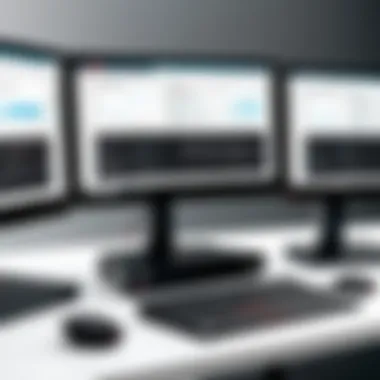
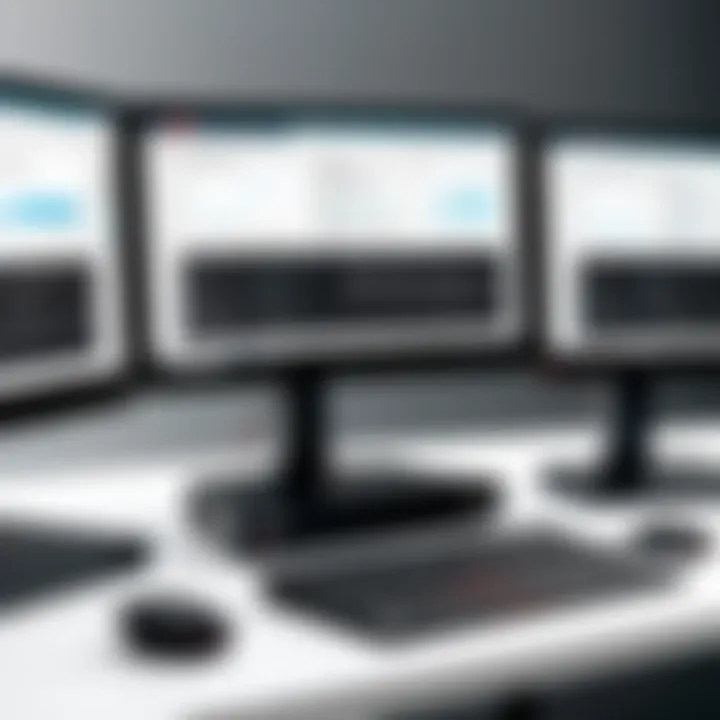
Understanding these specifications will help tailor the selection process to individual needs. The right monitor boosts productivity by minimizing eye strain and maximizing comfort and functionality. As such, it is a critical investment for professionals aiming to optimize their ThinkPad setup.
"The effectiveness of a dual-monitor setup significantly relies on the choice and configuration of each piece of equipment."
By comprehensively considering screen size, resolution, aspect ratio, and panel types, users can forge a setup that genuinely supports their productivity goals.
Setting Up the Additional Monitor
Setting up an additional monitor is a crucial aspect of enhancing your workspace efficiency with a ThinkPad. The integration of an extra display can lead to significant productivity gains, allowing you to manage multiple tasks more smoothly. This section delves into the essential components of establishing a dual-monitor system, focusing on the physical connections necessary for linking the devices and the configuration of various operating systems.
Physical Connections
Physical connections are the foundation of a successful multi-monitor setup. Begin by identifying the available ports on your ThinkPad. Common options include HDMI, DisplayPort, or USB-C. To ensure compatibility, you may need specific cables or adapters based on your monitor and ThinkPad specifications. Carefully check the monitor manual and ThinkPad documentation to verify the appropriate connection type. Once you plug in the cable, the display should automatically be recognized.
This element is important because a stable connection affects overall display performance. Incorrect or unstable connections can result in flickering, poor resolution, or even complete display failure. When setting up the monitor, make sure that the cables are securely connected and that the monitor is powered on.
Operating System Configuration
Once the physical connections are established, proper configuration within the operating system is necessary to achieve an efficient dual-screen experience. Each operating system—Windows, Linux, and MacOS—has its unique approach and features to set up additional monitors. Understanding these differences can streamline your setup process.
Windows Settings
In Windows, the process of configuring a second monitor is relatively straightforward. By right-clicking on the desktop and selecting the "Display settings," you can manage multiple displays. The key characteristic of Windows settings is its user-friendly interface, ideal for both beginners and experienced users alike. One beneficial feature of Windows settings is the ability to adjust the display order, resolution, and orientation with ease.
This flexibility allows users to customize their workspace according to individual preferences. However, some may face issues where the display is not recognized. Updating the graphics driver often resolves these problems, emphasizing the need to maintain current software.
Linux Settings
For Linux users, configuring an additional monitor can vary depending on the distribution and graphical environment in use. Tools like Xrandr offer command-line options for setting display parameters. One significant aspect of Linux is its versatility; advanced users may prefer command-line configuration for precise control. This can be beneficial for those who require tailored adjustments.
However, this complexity may pose a learning curve for novices. While Linux provides extensive customization, the setup can be daunting without adequate support resources. Therefore, familiarity with your specific environment is beneficial.
MacOS Settings
MacOS provides a seamless experience for setting up additional monitors. Users can access the "Displays" function in System Preferences to detect and configure connected monitors. The auto-detection feature of MacOS is one of its strengths, making it a popular choice for professionals seeking efficiency.
Additionally, the ability to arrange displays visually simplifies workspace organization. One common limitation is that older hardware may not fully support newer display technologies, which may require an upgrade for optimal use. Nevertheless, the intuitive nature of MacOS settings often encourages users to maximize their productivity with minimal hassle.
Setting up an additional monitor can greatly enhance productivity by allowing for a more organized and efficient workspace. Understanding the physical connections and operating system configurations ensures a smooth transition to a dual-monitor environment. As technology evolves, keeping up with the latest trends and features helps professionals make the most out of their work setup.
Maximizing Workspace Efficiency
Improving workspace efficiency is essential for professionals who rely on technology for their daily tasks. With a ThinkPad and an additional monitor, users can tailor their environment to suit their specific working styles. Efficiency is not merely about speed; it encompasses effective task management, organized workflows, and reduced distractions.
With the right setup, you can optimize how you interact with your projects. A dual-monitor configuration can enhance your overall productivity by allowing multiple applications to display simultaneously. Thus, keeping relevant information at hand without unnecessary toggling can significantly streamline your processes, allowing for smoother transitions between tasks.
Taskbar Management
Managing the taskbar in a multi-monitor setup can play a crucial role in maximizing workspace efficiency. It is advisable to customize the taskbars on each monitor according to your workflow needs. For instance, if you frequently use applications on specific monitors, you should pin them directly to the taskbar of the corresponding screen. This approach reduces the time spent searching for apps.
You can also choose to expand the taskbar across both monitors or keep individual taskbars separate. An expanded taskbar provides a cohesive view of open applications, whereas separate taskbars may help in organizing tasks based on priority or project. Here is a short guide for Windows settings:
- Right-click on the taskbar.
- Select "Taskbar settings."
- In the options, choose whether to display taskbars on all displays or just on the main display.
- Configure which shows the taskbar buttons to your preference.
Window Organization Techniques
Efficient window organization is critical in a dual-monitor setup. Using keyboard shortcuts to quickly manage the size and position of applications can save significant time. Windows 10, for example, offers useful shortcuts such as Snap Assist, allowing you to dock windows easily. Dragging a window to the edge of the screen will automatically resize it, making it occupy half of the monitor.
Moreover, consider using specialized software to manage window arrangements more effectively. Programs like DisplayFusion or Aquasnap provide enhanced functionality for window management, enabling you to create preset layouts based on your specific tasks. This can be especially helpful when switching between projects regularly.
Utilizing virtual desktops can also help in organizing applications without cluttering the physical monitors. Setting up virtual desktops allows you to segment tasks while keeping specific applications grouped effectively. This setup can significantly enhance focus, as you can toggle between different environments tailored for distinct activities without distraction.
"Effective window organization and taskbar management can reduce the cognitive load, allowing you to focus on the task at hand."
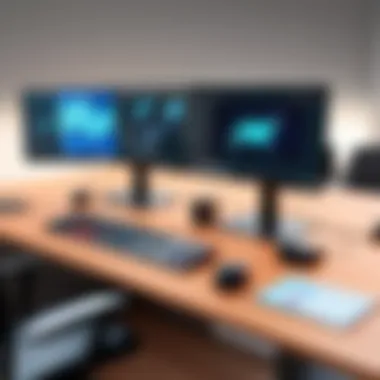
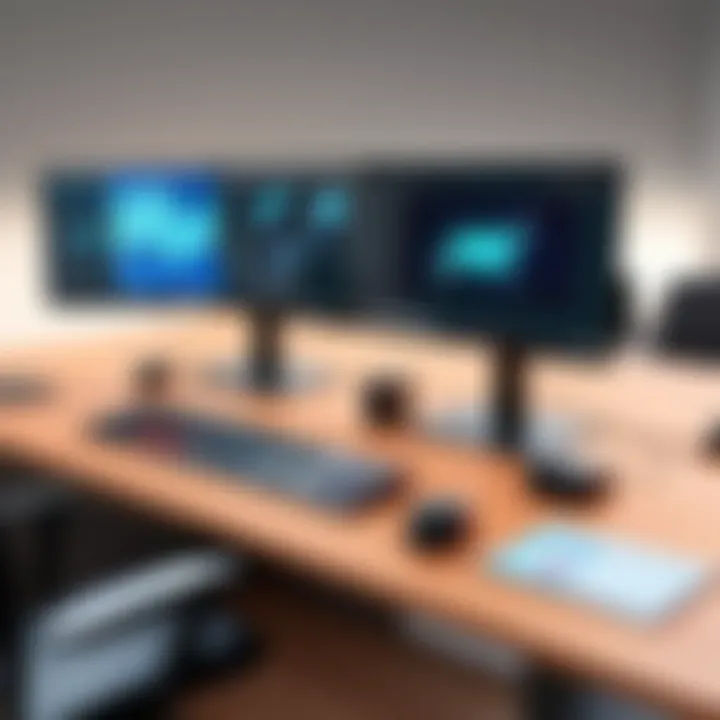
Common Challenges with Multi-Monitor Setups
When integrating an additional monitor with a Lenovo ThinkPad, several challenges may arise. Understanding these challenges is crucial because they can affect your productivity and overall experience. With proper knowledge, users can navigate these issues efficiently. This section sheds light on two main problems that often occur with multi-monitor setups: resolution and scaling issues, and connection problems.
Resolution and Scaling Issues
Resolution and scaling issues can significantly hinder the usability of a multi-monitor setup. Each monitor may have different native resolutions. When you connect a monitor with a higher resolution to your ThinkPad, it may lead to mismatched display settings. This situation results in text and images appearing too small or blurry on one or both screens, causing discomfort. Adjusting the scaling is often necessary to ensure that both displays look uniform.
To address these issues, users should check and adjust their display settings. In Windows, for instance, you can navigate to Settings > System > Display to configure resolution and scaling options for each screen. On MacOS, the process is similar but can be done via System Preferences > Displays.
Keep in mind, finding the right balance may require some trials. Users should ensure that font sizes are easy to read and that applications display correctly across both screens. Effective scaling can lead to a more seamless workflow.
Connection Problems
Connection problems often emerge when setting up an additional monitor. The most common issue is related to incompatible ports or cables. ThinkPads typically support HDMI and USB-C connections, but not every monitor may share these connection types. As a result, having the correct adapters is essential.
Furthermore, cable faults can also lead to frustrating problems. A damaged or low-quality cable might disrupt connections intermittently. Users should always check for cable integrity and compatibility before use.
Another factor to consider is the configuration in the operating system's display settings. Sometimes, the external monitor might not be detected at all. This situation can often be resolved by toggling the connection type or switching on display detection features.
Ultimately, resolving connection issues often requires a systematic approach. Users should consult their ThinkPad's user manual or Lenovo's support website for guidance on compatible devices and connectivity options. Each small step can save time and enhance productivity.
"Understanding the challenges of multi-monitor setups enables users to create a more productive and efficient workspace."
By acknowledging and addressing these common challenges, professionals can harness the full potential of their ThinkPad and additional monitor setup.
Troubleshooting Display Issues
In the realm of utilizing multiple monitors with a Lenovo ThinkPad, occasional display issues are inevitable. Understanding how to troubleshoot these problems is crucial for maintaining workflow efficiency. Display issues can stem from incorrect configurations, connection failures, or outdated software, leading to disruptions in productivity. This section examines some common challenges faced when setting up or using dual monitors, as well as effective strategies to resolve them.
Common Error Messages
Users may encounter several common error messages when configuring their additional monitor. Here are some of the most frequent:
- "No signal" This error typically occurs when the connected monitor is not detected due to connection issues. The cables might be loose, or the monitor may be powered off.
- "Display driver stopped responding and has recovered" This message indicates a problem with the graphics driver. It might momentarily halt the display, causing a flicker or black screen before returning to normal.
- "Out of range" This error means the monitor cannot display the selected resolution. It suggests that the display settings need adjustment to match the monitor’s supported resolution.
Resolving these issues usually requires a series of steps:
- Check the physical connections. Ensure all cables are securely connected to both the ThinkPad and the external monitor.
- Verify the monitor's power. Confirm the monitor is turned on and properly set up.
- Adjust display settings. Navigate to display settings to ensure the correct resolution and refresh rate is selected for the monitor.
"Unresolved display issues can lead to decreased productivity, which is crucial to avoid in professional settings."
Driver Updates and Rollbacks
Graphic drivers play a pivotal role in managing multi-monitor setups. Keeping them updated is essential for compatible display performance. However, there are times when an update may cause issues such as unexpected behavior or degraded performance. In such cases, rolling back to a previous version can be a viable solution.
Driver Updates
It is advisable to check for the latest graphics drivers regularly. Updates can bring enhancements, including bug fixes, performance improvements, and new features. Here’s how to check:
- Open Device Manager. Right-click on the Start button and select Device Manager.
- Locate Display Adapters. Find your graphics card under the Display Adapters section.
- Select Update Driver. Click on the option to search for updated driver software automatically.
Driver Rollbacks
If an update results in display problems, rolling back can help restore functionality. To perform a rollback:
- Open Device Manager. As before, right-click the Start button.
- Access Properties. Right-click on your graphics card and select Properties.
- Rollback Driver. If the option is available, click on it and follow the prompts to revert to the previous version.
In summary, troubleshooting display issues is vital for maintaining an optimal multi-monitor experience with your ThinkPad. By being aware of common error messages and understanding how to manage driver updates, users can ensure a smooth and effective workflow.
Maintaining Your ThinkPad and Monitor Setup
Maintaining your ThinkPad and monitor setup is crucial for ensuring optimal performance and longevity. Regular maintenance can lead to a significant enhancement in productivity and efficiency, particularly in professional environments where reliability is paramount. A well-maintained system minimizes disruptions, allows for smoother workflows, and extends the life of both your laptop and monitor. This section will cover key aspects of software and hardware maintenance to keep your devices in top condition.
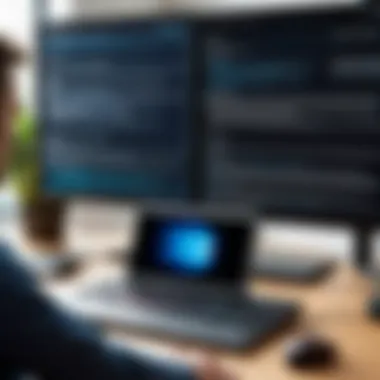
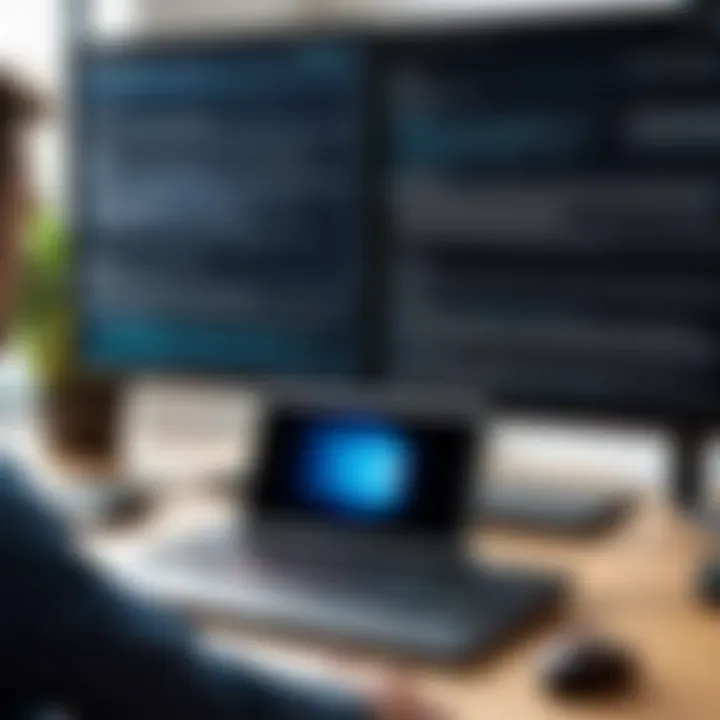
Regular Software Updates
Software updates are essential for maintaining the security and functionality of your ThinkPad and monitor. Manufacturers like Lenovo frequently release updates that include important patches and enhancements. These updates can improve system stability, fix bugs, and introduce new features that enhance your user experience. Keeping your operating system and applications up to date helps prevent compatibility issues between your ThinkPad and monitor.
Key Points to Consider:
- Always check for driver updates for your graphics card. This ensures that your monitor operates with the optimal settings.
- Update your operating system regularly. This can help prevent security vulnerabilities that may affect your data or system performance.
- For Windows users, regularly use Windows Update to check for the latest updates.
- For Linux users, utilize package management tools to keep your system package updated.
- On MacOS, updates can be managed through the App Store, ensuring that all installed applications are current.
Keeping your ThinkPad and monitor software updated is not just a recommendation. It is a necessity for a secure, smooth-working environment.
Hardware Maintenance Tips
Hardware maintenance is equally important for ensuring your setup functions effectively. Over time, dust and dirt can accumulate in your devices, impacting their performance. Regularly checking and cleaning both your ThinkPad and monitor improves their efficiency and can prevent overheating or other issues.
Effective Maintenance Strategies:
- Dust Cleaning: Use a microfiber cloth for the screen and a soft brush or compressed air for the keyboard and vents of your ThinkPad. This minimizes dust accumulation that can impede performance.
- Check Connections: Regularly inspect cables for wear or damage. Ensure that all connections are secure. Loose connections can result in display issues or data loss.
- Monitor Positioning: Make sure your monitor is at eye level and not positioned in a way that could lead to strain. Proper ergonomics prevent physical strain and can aid in productivity.
- Battery Care: For ThinkPads, avoid letting the battery fully deplete often. Maintain a charging cycle that keeps the battery healthy.
- Storage Conditions: Keep your devices in a clean, dry environment. Extreme temperatures and humidity can negatively affect performance.
By taking these maintenance steps, you contribute to the ongoing performance and reliability of your ThinkPad and monitor setup. Regular attention to both software and hardware aspects ensures that you continually benefit from enhanced productivity and efficiency.
Examining the Future of Multi-Monitor Technologies
The evolution of multi-monitor technologies is critical for maximizing productivity in a rapidly changing work environment. Understanding future trends helps professionals anticipate what tools and setups will best enhance their workflows. As organizations prioritize efficiency and adaptability, the integration of advanced display technologies becomes an essential consideration for IT experts and tech enthusiasts alike.
Emerging Display Technologies
Emerging display technologies are shaping how we view and utilize screens in our daily tasks. Innovations in OLED and Mini-LED technology are enhancing color accuracy and reducing power consumption. These developments lead to displays that are not only visually richer but also more energy-efficient.
Curved displays are gaining traction too. They offer a wider field of view and can reduce eye strain, particularly in setups where users work long hours. Furthermore, advancements in flexible screens provide possibilities for portable multi-monitor configurations, increasing mobility without compromising productivity.
"The future of displays lies in their ability to blend seamlessly into our working environments, making technology more accessible and user-friendly."
Additionally, features like high refresh rates and adaptive sync technologies are becoming standard. These enhancements are particularly beneficial for users engaged in graphic design or gaming. Here are some key emerging display technologies to watch:
- 4K and 8K Resolutions: Increased pixel density offers stunning image clarity.
- Touchscreen Capabilities: Enhances interaction with applications and multitasking.
- Integrated AI: Future models may utilize AI for automatic calibration and user experience optimization.
Trends in Workspace Design
Workspace design is evolving alongside technological advancements. Companies are rethinking physical layouts to maximize collaboration and productivity. A strong trend involves integrating multi-monitor setups into ergonomic design principles. The goal is to create adaptable environments catering to various work styles.
Open office spaces are now blending with elements that support privacy, like soundproof booths and individual workstations equipped with dual monitors. This not only supports intense focus sessions but also encourages collaboration when needed.
The rise of remote work has also influenced workspace design significantly. More professionals are demanding setups that enhance their home office efficiency. This leads to an increase in dual or multiple monitor configurations, allowing for better task management and fewer disruptions.
Important trends shaping the future workspace include:
- Modular Furniture: Furniture that can easily be reconfigured to support different tasks or group sizes.
- Tech-Integrated Desks: Desks with built-in power outlets and cable management systems.
- Personalization: Users are increasingly customizing their workspaces with personal touches and the tools that best meet their needs.
As the landscape of technology and workspace continues to evolve, embracing these changes will be essential for professionals striving for optimal efficiency.
End: Enhancing Your ThinkPad Experience
The integration of an additional monitor with Lenovo ThinkPad devices is not just a convenience; it is a powerful enhancement to productivity. Throughout this article, we have explored various aspects of this setup, from the technical specifications needed for compatibility to the practical benefits that arise from a dual-monitor environment. This conclusion synthesizes the key points while reinforcing the importance of making informed decisions regarding display setups.
Recap of Key Benefits
When considering the advantages gained from adding a monitor to your ThinkPad, several factors stand out:
- Increased Screen Real Estate: With two screens, users can multitask more efficiently. This setup allows for larger spreadsheets, multiple applications, or extensive documentation to be visible at once.
- Improved Focus: A dual-screen system can minimize distractions by dedicating one monitor to work and the other for communication tools or reference materials.
- Enhanced Collaboration: For professionals who work in teams, the additional screen allows for better sharing of information during meetings or brainstorming sessions. You can showcase presentations while keeping your notes easily accessible.
- Better Organization: Users can organize their workflows according to their preferences, which can reduce time spent switching between applications.
By embracing a dual-monitor workspace, ThinkPad users can capitalize on these benefits to streamline their daily tasks and elevate their overall efficiency.
Final Thoughts on Efficiency
In the fast-paced world of technology and business, efficiency is paramount. With a ThinkPad and an extra monitor, professionals can elevate their game. Consideration of work habits is essential when adapting your environment to suit your needs. Understanding the technical capabilities of your ThinkPad is also critical in achieving seamless integration with an additional display.
Ultimately, enhancing your ThinkPad experience through improved productivity is not just about physical hardware but also about how you implement and adapt to these changes in a practical manner. Taking charge of your workspace by investing in a quality monitor is a step toward realizing your potential in a technology-driven landscape.
"The key to improving workplace efficiency lies in the tools you choose and how you use them."
Striving for a better setup can lead to significant improvements in work quality and outcomes. By summarizing these insights, we provide a holistic view that can help guide decisions as you optimize your workspace for better productivity.



